
B.C. grower finds wood pellets a good fuel for his cut flower farm
Harry Quik grabs a long iron poker and opens the door of one of two large, cylindrical furnaces. The room is already hot, but when Quik rakes the poker through the coals, flames erupt and heat rushes through the tiny one-foot-wide door.
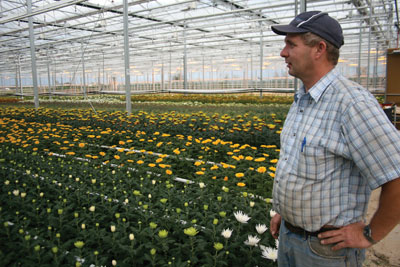 |
| Harry Quik surveys one of his greenhouses. (PHOTOS BY TYLER OLSEN) |
For the last three years, the environmentally friendly heat generated by this and another furnace has kept five-and-a-half acres of Quik’s greenhouses warm through cold snaps and chilly nights.
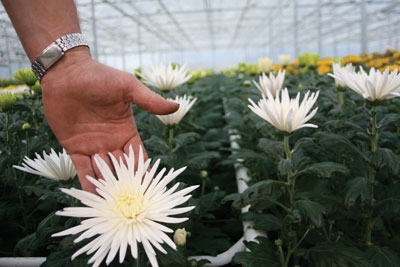 |
| Flower size and form have long made mums a cut flower favourite |
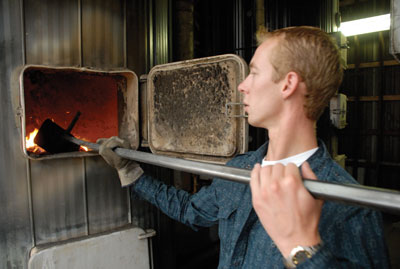 |
| Leo Quik, one of four sons and two daughters who help out in the family operation, stokes the furnace. |
 |
| Daisies are part of the product mix. |
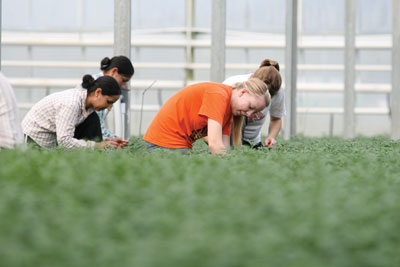 |
| Employees hard at work taking care of the crop. |
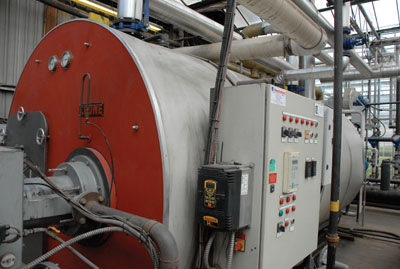 |
| A large tank holds recycled water waiting to be pumped and heated by the adjacent biomass burner |
Quik’s Farm – that’s the name of Harry Quik’s Chilliwack, B.C., flower operation – was one of many agri-cultural operations around the country that turned to alternative heating sources when natural gas prices began a rapid ascent at the start of the decade.
In 2004, Quik installed his first boiler. (While the setup henceforth will be called a “boiler,” that isn’t technically correct. The furnace heats recycled water to a temperature of 80ºC, 20º short of the boiling point, before piping the water into the greenhouse along the ceiling and between flower rows.) At the start, Quik burned coal and the impetus was clearly economic.
“You have to be business-minded enough to say, ‘how can we prevent getting pushed out?’” said Quik, who built his business from scratch after immigrating to Canada from the Netherlands 20 years ago.
MAKING THE FUEL SWITCH WHEN NATURAL GAS PRICES SOARED
Early on, the decision was paying off quick – with natural gas prices at record levels.
But the cost of gas fell by half in 2007. After another wild jump in 2008, it is now down to the levels of several years ago.
And while the boiler is still saving him money, these days Quik advises farmers looking to cut heating costs to consider “better heat retention systems” before changing fuel sources.
But up-front costs are no longer the only things a farmer needs to consider.
Three years ago, with concern about global warming at its zenith, Quik installed his second boiler and began burning wood pellets – a form of biomass that burns cleaner, though not as hot. The wood pellet fuel creates fewer ashes, making the boiler easier to maintain, and with British Columbia still recovering from the devastation wrought by the mountain pine beetle, there is plenty of scrap wood that is decaying and will be releasing its carbon, one way or another.
Turning to biomass has dramatically reduced the environmental footprint of Quik’s operation. An independent analysis verified that the farm reduced its carbon dioxide emissions by nearly 90 per cent in nine months after it began burning the pellets. Even better, Quik turned his new green heating source into a revenue source by selling carbon offsets to the Pacific Carbon Trust, a British Columbia crown corporation that allows companies and municipalities to “offset” their carbon footprints by buying a stake in reduction programs.
ELIMINATING 8,000 TONNES OF CO2 EMISSIONS OVER FIVE YEARS
The conversion to biomass promises to stop 8,000 tonnes of CO2 from entering the atmosphere over five years – the equivalent of more than 2,000 cars. And with Pacific Carbon Trust selling offsets for as much as $20 per tonne, there is serious money to be made – at least in B.C.
Inside the furnace room, Quik points to a pyramid-shaped metal unit that scrubs the furnace’s output of particulate material before it is released skyward. The boiler, consequently, produces little to no pollution.
Politicians, he said, “don’t know that we try to filter our particulate matter as much as possible.”
A good neighbour, Quik and his family hosted an open house for those interested in a closer look at the farm. If someone asks, he will discuss his biomass boilers. But he’s not going to go out of his way to place them in the spotlight.
For now, he’s happy growing his chrysanthemums and lilies greener than ever.
Tyler Olsen is a freelance writer and photographer in British Columbia.
Print this page